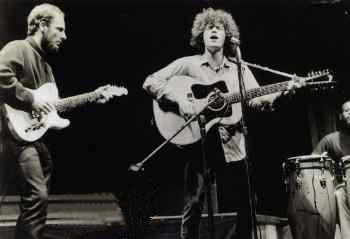by
Lee Underwood
pp.
ix-xiii
Prelude
A
STARSAILOR’S LIFE When
Tim Buckley and I met in Greenwich Village in the spring of 1966,
we were a study in contrasts. He was a Loara High School graduate from Bell Gardens
and Anaheim, California, who had attended nearby Fullerton Junior College (now
Community College) for two months and dropped out. I had graduated from San Francisco
State College and done some graduate work at UC Berkeley. Tim had worked at a
Taco Bell. I had worn a suit and tie and taught English for one year at The Peddie
School in Hightstown, New Jersey, a posh private high school for boys near Princeton.

©
Unknown
Author Lee Underwood on stage with Tim | Tim
hailed from Orange County’s blue-collar neighborhoods, and had abandoned
his wife, Mary, to come to New York, where, according to him, he was later informed
she was pregnant. He had written a handful of songs that constituted a synthesis
of the lives he and his friend and talented co-lyricist Larry Beckett had experienced
in high school.
He had just signed a recording contract with Elektra Records. I owned three acoustic
guitars, had abandoned my wife, had one year’s experience singing and playing
my own songs, but had no contract with anybody, and no work in sight. I didn’t
care. I was taking my shot. So was Tim. The Big Apple. We liked each other and
teamed up, with me as his lead guitarist. For
some seven years we worked and played together—clubs, concerts, records,
TV shows, wine, women, song. The last time I performed with him was on a Greetings
From L.A. tour in early 1973. In April 1975, I saw him perform at the Golden Bear
in Huntington Beach, where I met his ex-wife Mary and their eight-year-old son,
Jeff, who was later to become a first-class singer and songwriter in his own right.
The
last time I saw Tim on stage was May 9-11, 1975, at a three-night whirlwind get-down
roadhouse funk-rock gig at the Starwood club in Hollywood. I attended every performance,
and had never seen him in better shape. The
last time I saw him at all he was dead. An overdose of alcohol and heroin killed
him on June 29, 1975, age twenty-eight.
MULTIPLE
PERSPECTIVES
Part
I, Blue Melody: The Life is a celebration of Tim Buckley and
his multifaceted personality, a musical appraisal, a partial biography, a heartfelt
memoir. I focus on Tim not only as a young man coming of age, but as a dedicated
artist whose evolutionary creative journey was nothing short of extraordinary.
Part
I draws from direct personal experiences, showcasing my recollections of playing
lead guitar with Tim during the sixties and early seventies, including behind-the-scenes
anecdotes with explicit details about the wild, wonderful, strange, whimsical,
and sometimes dangerously crazy things we were involved with. It also draws from
exclusive interviews, conversations, and letters, as well as solid research into
interviews and articles written by others while Tim was alive. It spotlights his
story, my story, and the music we played, celebrating the people we knew and the
tumultuous times we lived in. Part
II, Timewinds, touches
upon a few of the many complex circumstances surrounding Tim’s rather sordid
death, the funeral, the aftermath. I
am happy to include exclusive interviews of my own with some of Tim’s key
family members, friends, loved ones, and bandmates, and to bring to light certain
biographical information and quotes from writings by various outside journalists.
However, it is not my intention to include everybody’s viewpoint, or to reduce
all viewpoints to equal value, or to cover each and every external detail of Tim’s
life. I leave that to biographers. For
the most part, I discuss events and conversations in which I participated. I often
quote from Tim’s interviews with other writers, giving appreciation and due
credit to them in the Sources section, so we might have his exact words regarding
matters he spoke directly with me about, or regarding matters that need to be
included for their insight and informational value, whether I was personally present
or not. Also,
in the interest of readablity I have used quotations to reflect certain conversations
between various people, although I may not have been present at the time the conversations
took place. While the words in these quotations likely were not the exact ones
used, they reflect the substance of those conversations as they were told me.
Tim
was intelligent and insightful right from the beginning, but it is fascinating
to watch the ways in which his language evolved as he himself evolved psychologically
and artistically. Linguistically, he moved from the blue-collar profanities and
light-hearted street-rat vulgarities of his youthful background in Bell Gardens
and Anaheim, to the obscenity-free, highly articulate, and even graceful elegance
of his later interviews with Frankie Nemko, Sam Bradley, and Michael Davis. My
loyalty is to the truth of Tim and the music and to my own experiences of the
context in which we lived—the music, the times, the people we knew. That
does not mean I am blinded by friendship. To the contrary—I am no idolater,
and know all too well he had his faults and weaknesses. But I also know that I
see clearly the totality of his contributions as an individual and as an artist.
I have come to see the whole of the man and his life and work—the goods and
bads, the ups and downs, the strengths and limitations, the joy and heartbreak—and
that is what I am presenting in this book. I am equally forthright about my own
strengths, contributions, weaknesses, mistakes, and shortcomings during those
years. What
an extraordinary adventure Tim’s musical voyage has been! And the music lives
on, happy to say, vindicating those who from the beginning knew it would endure.
This is very satisfying, of course. Very satisfying, indeed.
|